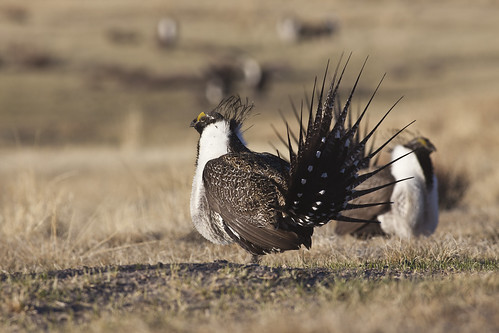
Bi-State sage-grouse live at the California-Nevada border, and biologists estimate that between 1,800 and 7,400 of these ground-dwelling birds inhabit about 4.5 acres of sagebrush habitat. Bureau of Land Management photo.
We can achieve more when we voluntarily work together, and the decision today not to list the Bi-State sage-grouse under the Endangered Species Act proves the power of partnerships. In this case, collectively, we were able to proactively conserve and restore habitat for this geographically distinct sage-grouse.
USDA’s Natural Resources Conservation Service works with conservation partners and ranchers in Nevada and California to take steps to benefit sage-grouse habitat while also helping ranchers improve their ranching operations. Meanwhile, this work helps connect public lands like national forests, where U.S. Forest Service is working to restore habitat, too.
Through the Sage-Grouse Initiative, NRCS has already helped ranchers accelerate implementation of critical conservation actions by investing $20 million with partners to restore and protect important habitats – both through conservation easements and by removing invading conifer trees. The Forest Service has invested an additional $3 million in treatments to improve the sagebrush ecosystem and this summer will begin work on an additional 29,000 acres.
Easements help ranchers keep private lands that provide key summer habitats with water intact and productive. To date, NRCS has worked with private landowners to enroll 7,300 acres of high priority habitat with an additional 4,500 acres in progress. These conservation easements protect critical sage grouse brood rearing habitats and connective corridors. The private lands harbor precious water resources that sage grouse use heavily in summer.
Ranchers have also restored thousands of acres of important sagebrush-steppe by carefully removing the early invading pinyon and juniper trees. These actions not only address a primary threat facing the birds, but also benefit other wildlife, such as mule deer, antelope and sage sparrow, and create better forage for livestock.
Collaborative work for the Bi-State sage-grouse began a decade ago, when a group of ranchers, government agencies and conservation groups came together to form the Bi-State Local Area Working Group. The group released the Bi-State Action Plan in 2012 to guide scientifically-based conservation efforts that ensure the most important threats are addressed in areas where biological benefits are greatest.
As a partner working to voluntarily implement the Bi-State Action Plan, USDA in 2014 pledged an additional $25.5 million in SGI funding to further accelerate bi-state conservation across public and private boundaries.
As you know, sage-grouse don’t recognize our borders. They fly and walk across public and private lands as one landscape, and it’s important we have come together to put aside those ‘borders’ and focus on getting the job done across public and private lands – voluntarily.
While we celebrate this victory for the Bi-State sage-grouse, our work isn’t done. Conservation success for the Bi-State sage-grouse illustrates what’s possible for the greater sage-grouse when all partners voluntarily roll up their sleeves and work together.
USDA is working actively with partners and ranchers to restore habitat for all sage grouse across 11 western states through SGI. In the past five years, NRCS has invested $296.5 million and conserved or protected more than 4.4 million acres of sage grouse habitat, an area twice the size of Yellowstone National Park. USDA has recently pledged to extend SGI funding by $200 million through 2018, the life of the current Farm Bill.
Learn more about the Sage-Grouse Initiative. For more on technical and financial assistance available through conservation programs, visit nrcs.usda.gov/GetStarted or a local USDA service center.

Side view of a bi-state sage-grouse. Bureau of Land Management photo.
No comments:
Post a Comment
Note: Only a member of this blog may post a comment.